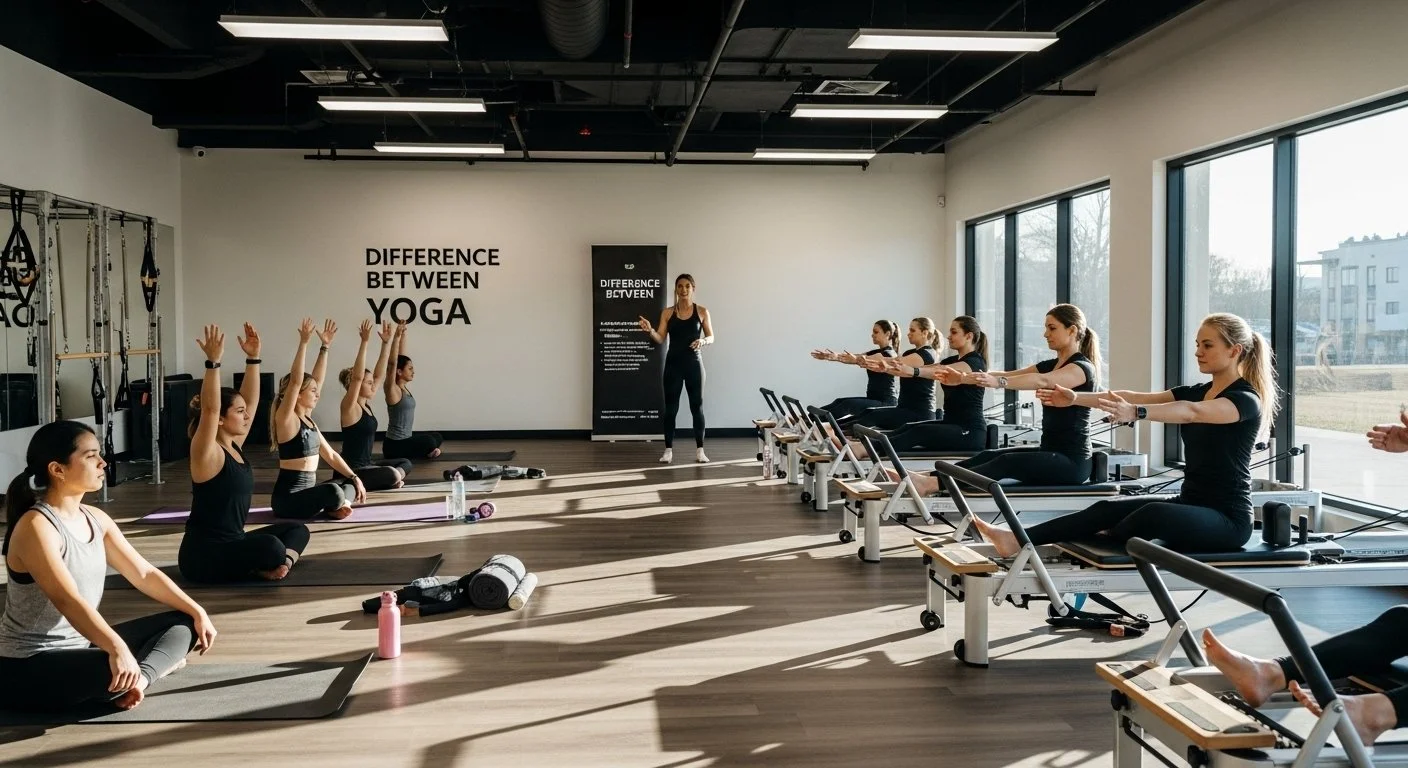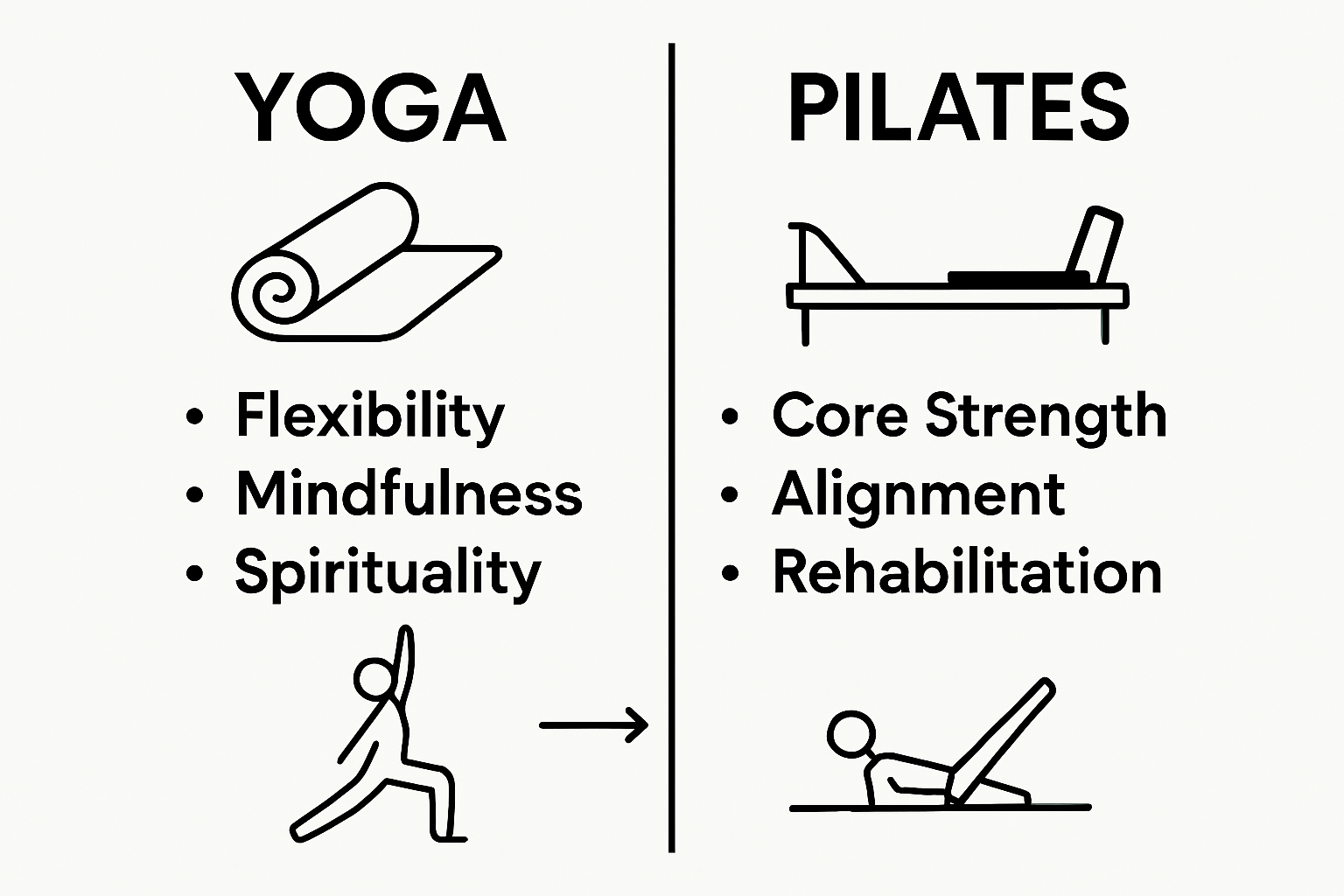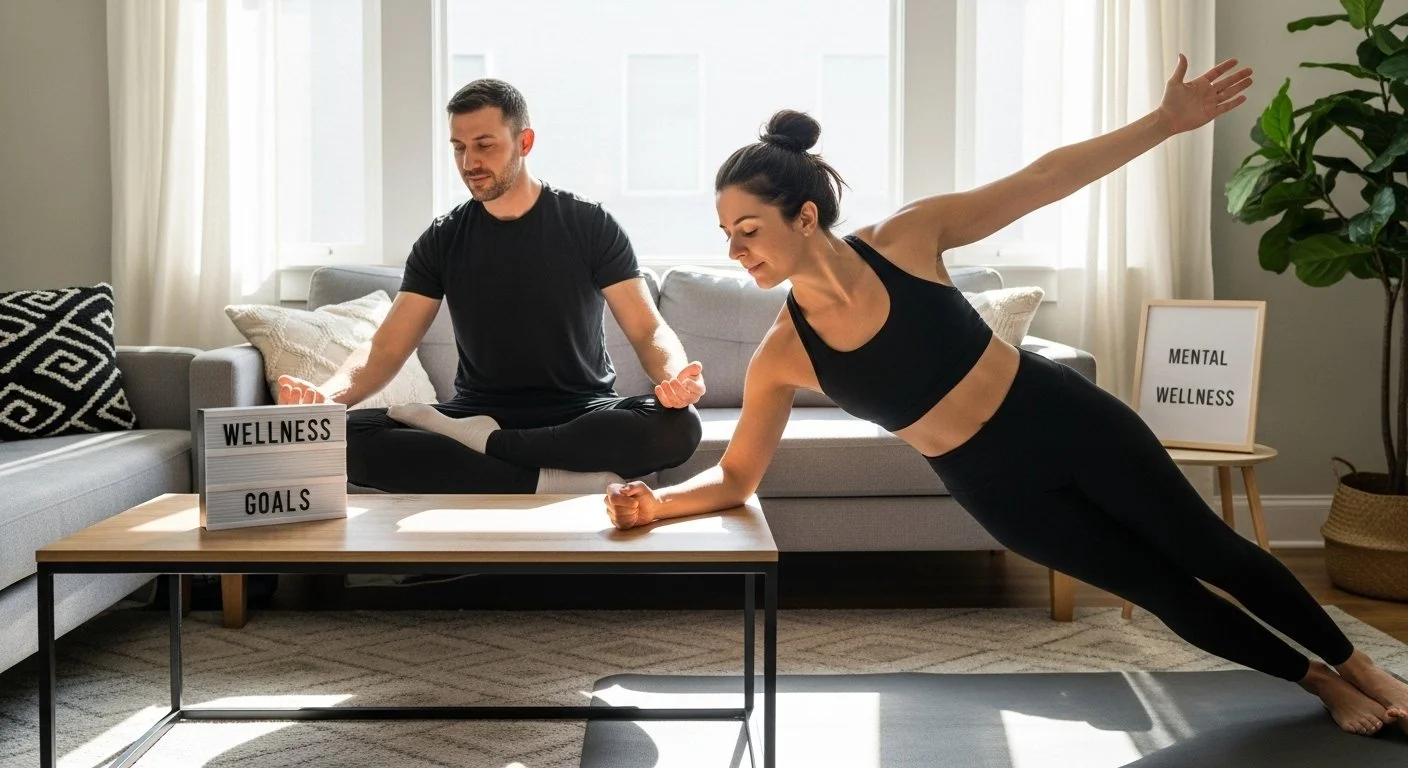Understanding the Difference Between Pilates and Yoga
Heather Rice
People often think yoga and Pilates are nearly the same because both improve strength and flexibility. Here is the surprising part. Although yoga has roots that go back over 5,000 years, Pilates was designed less than a century ago in wartime Europe for physical rehab. This difference in origin completely changes how each practice affects your mind and body.
Table of Contents
Quick Summary
TakeawayExplanationYoga emphasizes mental clarity and flexibility.This practice integrates physical movement with mindfulness techniques to reduce stress and enhance emotional resilience.Pilates focuses on core strength and postural alignment.With a foundation in controlled movements, Pilates targets muscle conditioning and is particularly helped in rehabilitation.Choose based on personal health goals.Assessing your own fitness objectives and limitations can guide whether yoga or Pilates suits you better.Both practices can complement each other.Integrating yoga and Pilates allows individuals to benefit from the strengths of each approach for overall wellness.Consult professionals if injured or limited.Always seek advice from healthcare providers before starting a new fitness practice, especially if you have physical constraints.
What are Pilates and Yoga? An Overview
Pilates and yoga represent two foundational wellness practices that focus on strengthening physical and mental connections, yet they differ significantly in their origins, techniques, and primary objectives. Both practices aim to improve overall well-being but approach this goal through distinct philosophical and physical methodologies.
To help clarify the distinctions between Pilates and yoga, the following table compares their origins, philosophical foundations, primary objectives, movement styles, and key equipment used.
FeatureYogaPilatesOriginAncient India, ~5,000 years agoEarly 20th-century EuropePhilosophical FoundationSpiritual unification of mind, body, and spiritPhysical conditioning and scientific body movementPrimary ObjectiveFlexibility, mindfulness, and inner transformationCore strength, postural alignment, and rehabilitationMovement StyleFluid, dynamic poses integrated with breathPrecise, controlled movements focusing on muscle groupsEquipmentUsually minimal (mat)Can involve machines (reformer, cadillac, etc.) or matMental/Spiritual FocusEmphasized (meditation, self-awareness)Minimal, more physical focusPractice StructureSequence varies by style; includes meditationStructured routines with emphasis on technique
Origins and Philosophical Foundations
Yoga emerged thousands of years ago in ancient India as a holistic spiritual practice designed to unite mind, body, and spirit. Its roots trace back to meditative traditions that emphasized inner transformation and connection with universal consciousness. Yoga Journal notes that traditional yoga encompasses not just physical postures but also breath control, meditation, and ethical principles.
In contrast, Pilates is a more modern practice developed by Joseph Pilates in the early 20th century. Initially created to rehabilitate wounded soldiers during World War I, Pilates focuses primarily on physical conditioning, core strength, and precise movement patterns. The method emphasizes body alignment, muscle balance, and controlled movements.
Key Characteristics and Practice Differences
The fundamental difference between Pilates and yoga lies in their primary objectives and approach to movement.
Yoga practices typically include:
Varied posture sequences (called asanas)
Emphasis on flexibility and mental meditation
Spiritual and philosophical components
Breathing techniques integrated with movement
Pilates, by comparison, concentrates on:
Targeted muscle strengthening
Core stability and postural alignment
Precise, controlled movements
Rehabilitation and athletic performance enhancement
For those interested in exploring how these practices can complement each other, our guide on combining yoga and Pilates for wellness offers deeper insights into their synergistic potential.
The Origins and Philosophy Behind Pilates and Yoga
The historical and philosophical foundations of yoga and Pilates reveal profound insights into their unique approaches to physical and mental wellness. While both practices aim to transform human potential, they emerge from distinctly different cultural and historical contexts.
Ancient Spiritual Roots of Yoga
Yoga originated in ancient India approximately 5,000 years ago, deeply intertwined with spiritual and philosophical traditions. National Center for Complementary and Integrative Health highlights that yoga was not merely a physical practice but a comprehensive system of spiritual development. The earliest references appear in the Rig Veda, an ancient Sanskrit text that describes yoga as a method of spiritual discipline and meditation.
Traditional yoga philosophy encompasses several key principles:
Interconnectedness of mind, body, and spirit
Pursuit of inner peace and self-realization
Ethical living through principles like non-violence and truthfulness
Transcendence of individual ego
Alignment with universal consciousness
Modern Development of Pilates
In stark contrast, Pilates represents a 20th-century approach to physical conditioning, developed by Joseph Pilates during World War I. His method, initially called "Contrology," emerged from his personal experience rehabilitating injured soldiers and studying various movement disciplines. Joseph Pilates designed his system as a precise, scientific approach to body conditioning.
Pilates philosophy centers on:
Deliberate, controlled physical movements
Strengthening core muscle groups
Improving body alignment and posture
Enhancing overall physical performance
Creating balance between strength and flexibility
Learn more about how Pilates techniques evolvedand its transformation from rehabilitation method to global wellness practice. While their origins differ dramatically, both yoga and Pilates share a fundamental commitment to holistic human potential, offering practitioners pathways to physical discipline, mental clarity, and personal transformation.
Key Differences in Techniques and Practices
While yoga and Pilates share a commitment to holistic wellness, their techniques, movement patterns, and core objectives diverge significantly. Understanding these distinctions helps practitioners choose the most appropriate practice for their personal health goals.
Movement and Breathing Approaches
National Institutes of Health researchhighlights the fundamental technical differences between these practices. Yoga emphasizesfluid, dynamic movementsthat flow between postures, with breathing techniques serving as a critical bridge between physical and mental states. Practitioners use breath to guide movement, creating a meditative experience that connects physical exertion with inner awareness.
Pilates, conversely, focuses on precise, controlled movements with minimal repetitions.
Each motion is performed with extreme intentionality, targeting specific muscle groups and maintaining strict body alignment. Breathing in Pilates is more structured, typically coordinated with muscle engagement to enhance core stability and muscular control.
Equipment and Practice Styles
The equipment and practice styles further distinguish these disciplines:
Yoga Practice Characteristics:
Minimal equipment required (typically just a mat)
Multiple styles ranging from gentle (Hatha) to intense (Power Yoga)
Emphasis on flexibility, balance, and mental focus
Can be practiced in group or individual settings
Incorporates meditation and spiritual elements
Pilates Practice Characteristics:
Often uses specialized equipment like reformers, cadillacs, and stability chairs
Highly structured and precise movement sequences
Strong focus on core strength and postural alignment
Can be mat-based or machine-based
Primarily physical conditioning with rehabilitation potential
Performance and Health Benefits
Both practices offer unique health benefits, but their approaches differ. Yoga tends to improve overall flexibility, stress reduction, and mental well-being. Pilates concentrates on muscular strength, particularly core muscles, and precise body mechanics.
Explore how these practices can complement each other in our wellness guide, revealing how integrating both can create a comprehensive fitness approach that addresses physical and mental health simultaneously.
Benefits of Practicing Pilates vs Yoga
While Pilates and yoga might seem similar on the surface, each practice offers unique health benefits that address different aspects of physical and mental wellness. Understanding these distinctive advantages helps individuals choose the most appropriate practice for their personal health goals.
Physical Health and Muscular Development
National Institutes of Health researchdemonstrates that Pilates excels in developingcore strength, muscular endurance, and precise body mechanics. The practice systematically targets deep muscle groups, creating a strong, balanced physique with enhanced postural alignment. Pilates is particularly beneficial for:
Rehabilitation from muscle or joint injuries
Improving overall body stability
Developing targeted muscle strength
Enhancing athletic performance
Reducing chronic lower back pain
Mental Wellness and Stress Reduction
Yoga stands out for its profound impact on mental and emotional well-being.
Unlike Pilates' physical focus, yoga integrates physical movement with mindfulness practices that directly address stress, anxiety, and emotional regulation. Key mental health benefits include:
Reducing symptoms of depression and anxiety
Improving meditation and breathing techniques
Enhancing emotional resilience
Promoting inner peace and self-awareness
Developing mindfulness skills
Complementary Practices for Holistic Wellness
Interestingly, Pilates and yoga are not mutually exclusive but can be complementary practices. While Pilates provides precise muscular conditioning, yoga offers holistic mind-body integration. Athletes, rehabilitation patients, and wellness enthusiasts often combine both practices to achieve comprehensive physical and mental fitness.
Learn more about combining yoga and Pilates for optimal wellnessand discover how these practices can work together to support your health journey. The key is understanding your personal wellness goals and selecting practices that align with your physical and mental needs.
This table summarizes the major benefits of Pilates and yoga, focusing on their distinct advantages for physical health, mental wellness, and potential for complementary practice.
Benefit AreaYoga HighlightsPilates HighlightsPhysical HealthImproves flexibility and balanceBuilds core strength and muscular enduranceInjury RehabilitationSupports gentle movement and recoveryEspecially effective for rehabilitation and postureMental WellnessReduces stress and anxiety; boosts mindfulnessEnhances body awareness and concentrationEmotional ResiliencePromotes self-awareness and inner peaceLess direct; focus on physical improvementPractice AdaptabilityAccessible to most fitness levels and needsAdaptable, with mat or machine optionsComplementary PotentialIntegrates easily with other mind-body practicesComplements yoga for balanced wellness
Choosing the Right Practice for Your Wellness Journey
Selecting between Pilates and yoga is not about determining which practice is superior, but understanding which approach best aligns with your individual wellness goals, physical condition, and personal preferences. The decision requires careful self-reflection and consideration of multiple factors.
Assessing Personal Health Objectives
Physical fitness goals play a critical role in selecting the most appropriate practice. Pilates might be ideal if you are seeking:
Targeted core muscle strengthening
Precise body mechanics rehabilitation
Enhanced athletic performance
Improved posture and alignment
Specific muscle group conditioning
Yoga becomes the preferred choice when your objectives include:
Stress reduction and mental clarity
Overall flexibility improvement
Spiritual and mindfulness development
Holistic mind-body connection
Emotional resilience building
Understanding Individual Physical Limitations
American Council on Exerciserecommends consulting healthcare professionals when selecting a fitness practice, especially if you have pre-existing conditions. Individuals with specific physical constraints should consider:
Current injury status
Mobility restrictions
Chronic pain conditions
Rehabilitation requirements
Overall physical fitness level
Exploring Hybrid and Complementary Approaches
Many wellness practitioners discover that combining Pilates and yoga creates a comprehensive fitness strategy. This integrated approach allows individuals to leverage the unique strengths of both practices. Discover beginner-friendly approaches to mindful movement that can help you start your wellness journey with confidence and proper guidance.
Ultimately, the most successful wellness practice is one that you enjoy, can maintain consistently, and provides tangible benefits to your physical and mental health. Experiment, remain open-minded, and listen to your body throughout the process.
Tailor Your Wellness Journey with Amrita Yoga & Wellness
Have you discovered how different Pilates and yoga can be, but still feel unsure about which practice fits your goals? Many people struggle to choose between core-focused, precise movement and mind-body spiritual connection. At Amrita Yoga & Wellness, we bridge this gap so you never have to compromise your physical or mental wellness.
Experience for yourself the benefits discussed in "Understanding the Difference Between Pilates and Yoga." Join our welcoming community in Philadelphia with expert-led classes for every level, from muscle-strengthening Pilates to calming yoga styles. Sign up right now at Amrita Yoga & Wellness, or see how our beginner yoga classes can help you start with confidence. Unsure if you want something new? Explore our guide for tips on combining yoga and Pilates for wellness and take your first step toward balanced, holistic self-care today.
Frequently Asked Questions
What is the main difference between Pilates and yoga?
The primary difference lies in their focus: Pilates is centered on physical conditioning, core strength, and precise movements, while yoga emphasizes flexibility, mental meditation, and spiritual elements.
Can Pilates and yoga be practiced together?
Yes, combining Pilates and yoga can create a comprehensive fitness approach that enhances both physical conditioning and mental wellness, allowing practitioners to benefit from the strengths of each practice.
What health benefits can I expect from practicing Pilates?
Practicing Pilates can lead to improved core strength, postural alignment, stabilization, and rehabilitation from injuries, as well as overall muscular endurance and balance.
How does yoga contribute to mental wellness?
Yoga integrates physical movement with mindfulness techniques, providing benefits such as reduced stress, anxiety alleviation, improved emotional resilience, and enhanced self-awareness.



